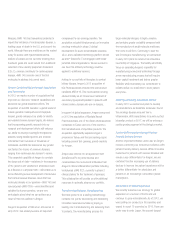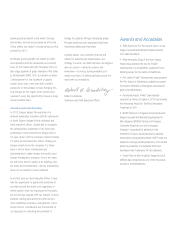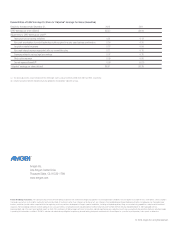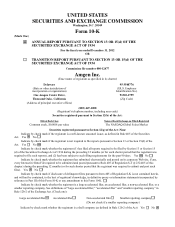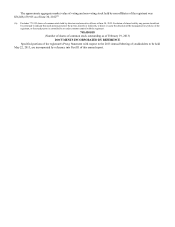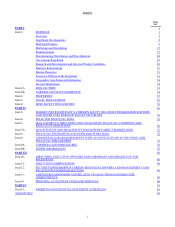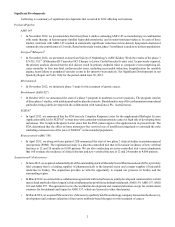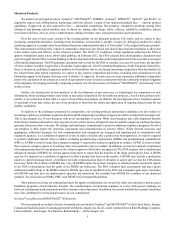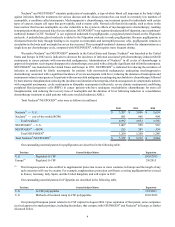Amgen 2012 Annual Report Download - page 10
Download and view the complete annual report
Please find page 10 of the 2012 Amgen annual report below. You can navigate through the pages in the report by either clicking on the pages listed below, or by using the keyword search tool below to find specific information within the annual report.3
Marketed Products
We market our principal products, Neulasta®, NEUPOGEN®, ENBREL, Aranesp®, EPOGEN®, XGEVA® and Prolia®, in
supportive cancer care, inflammation, nephrology and bone disease. Certain of our marketed products face — and our product
candidates, if approved, are also expected to face — substantial competition. Our products’ competitive positions among other
biological and pharmaceutical products may be based on, among other things, safety, efficacy, reliability, availability, patient
convenience/delivery devices, price, reimbursement, timing of market entry and patent position and expirations.
Over the next several years, certain of the existing patents on our principal products will expire, and we expect to face
increasing competition thereafter, including from biosimilars. A biosimilar is another version of a biological product for which
marketing approval is sought or has been obtained based on a demonstration that it is “biosimilar” to the original reference product.
This demonstration will typically consist of comparative analytical, preclinical and clinical data from the biosimilar to show that
it has similar safety and efficacy as the reference product. The 2010 U.S. healthcare reform legislation authorized the FDA to
approve biosimilars under a new, abbreviated pathway. In February 2012, the FDA released three draft guidance documents that
provide insight into the FDA’s current thinking on the development of biosimilars and broad parameters for the scientific assessment
of biosimilar applications. The FDA guidance documents leave room for the FDA to consider, on a case-by-case basis, the specifics
of what evidence would be required for a biosimilar to gain approval. (See Government Regulation.) In the European Union (EU),
there is already an established regulatory pathway for biosimilars and we are facing increasing competition from biosimilars. In
the United States after patent expiration, we expect to face greater competition than today, including from manufacturers with
biosimilars approved in Europe, that may seek to obtain U.S. approval. In some cases we may experience additional competition
prior to the expiration of our patents as a result of agreements we have made in connection with the settlement of patent litigation
with companies developing potentially competing products. See the discussions of Neulasta®/NEUPOGEN® and Aranesp® later
in this section.
Further, the introduction of new products or the development of new processes or technologies by competitors or new
information about existing products may result in increased competition for our marketed products, even for those protected by
patents, or in a reduction of price that we receive from selling our products. In addition, the development of new treatment options
or standards of care may reduce the use of our products or may limit the utility and application of ongoing clinical trials for our
product candidates.
In addition to the challenges presented by competition, our existing products and product candidates are also subject to
increasing regulatory compliance requirements that could be imposed as conditions of approval or after a product has been approved.
This is increasingly true of new therapies with novel mechanisms of action. While such therapies may offer important benefits
and/or better treatment alternatives, they may also involve relatively new or higher levels of scientific complexity and may therefore
generate increased safety concerns. We design and implement comprehensive proactive pharmacovigilance programs for all of
our products to help ensure the detection, assessment and communication of adverse effects. When deemed necessary and
appropriate, additional measures for risk communication and mitigation are designed and implemented in consultation with
regulatory agencies. As a condition of approval or due to safety concerns after a product has been approved, we may be required
to perform additional clinical trials or studies, including postmarketing requirements (PMRs) and postmarketing commitments
(PMCs). A PMR is a trial or study that a sponsor company is required by statute or regulation to conduct. A PMC is a trial or study
that a sponsor company agrees to in writing, but is not required by law, to conduct. In addition, we may be required to implement
risk management plans for our products in the various regions in which they are approved. The FDA requires risk evaluation and
mitigation strategies (REMS) for various approved products to ensure that the benefits of the drugs outweigh the risks. A REMS
may also be imposed as a condition of approval or after a product has been on the market. A REMS may include a medication
guide or a patient package insert, a healthcare provider communication plan or elements to assure safe use that the FDA deems
necessary. While the elements of REMS may vary, all REMS require the sponsor company to submit periodic assessment reports
to the FDA to demonstrate that the goals of the REMS are being met. The FDA evaluates such assessments and may require
additional modifications to the REMS elements. REMS may also be modified as the FDA and companies gain more experience
with REMS and how they are implemented, operated and monitored. We currently have REMS for a number of our marketed
products. See discussion on PMRs, PMCs and REMS in Government Regulation.
Most patients receiving our principal products for approved indications are covered by either government or private payer
healthcare programs, which influence demand. The reimbursement environment continues to evolve with greater emphasis on
both cost containment and demonstration of the economic value of products. In addition, the current worldwide economic conditions
have also contributed to increasing pressures on cost containment.
Neulasta® (pegfilgrastim)/NEUPOGEN® (Filgrastim)
We were granted an exclusive license to manufacture and market Neulasta® and NEUPOGEN® in the United States, Europe,
Canada and Australia under a licensing agreement with Kirin-Amgen, Inc. (K-A), a joint venture between Kirin Holdings Company,
Limited (Kirin), and Amgen. See Business Relationships — Kirin-Amgen, Inc.


